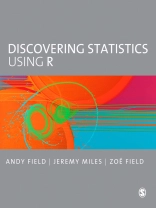Keeping the uniquely humorous and self-deprecating style that has made students across the world fall in love with Andy Field′s books, Discovering Statistics Using R takes students on a journey of statistical discovery using R, a free, flexible and dynamically changing software tool for data analysis that is becoming increasingly popular across the social and behavioural sciences throughout the world.
The journey begins by explaining basic statistical and research concepts before a guided tour of the R software environment. Next you discover the importance of exploring and graphing data, before moving onto statistical tests that are the foundations of the rest of the book (for example correlation and regression). You will then stride confidently into intermediate level analyses such as ANOVA, before ending your journey with advanced techniques such as MANOVA and multilevel models. Although there is enough theory to help you gain the necessary conceptual understanding of what you′re doing, the emphasis is on applying what you learn to playful and real-world examples that should make the experience more fun than you might expect.
Like its sister textbooks, Discovering Statistics Using R is written in an irreverent style and follows the same ground-breaking structure and pedagogical approach. The core material is augmented by a cast of characters to help the reader on their way, together with hundreds of examples, self-assessment tests to consolidate knowledge, and additional website material for those wanting to learn more.
Given this book′s accessibility, fun spirit, and use of bizarre real-world research it should be essential for anyone wanting to learn about statistics using the freely-available R software.
Innehållsförteckning
Why Is My Evil Lecturer Forcing Me to Learn Statistics?
What will this chapter tell me?
What the hell am I doing here? I don′t belong here
Initial observation: finding something that needs explaining
Generating theories and testing them
Data collection 1: what to measure
Data collection 2: how to measure
Analysing data
What have I discovered about statistics?
Key terms that I′ve discovered
Smart Alex′s tasks
Further reading
Interesting real research
Everything You Ever Wanted to Know About Statistics (Well, Sort of)
What will this chapter tell me?
Building statistical models
Populations and samples
Simple statistical models
Going beyond the data
Using statistical models to test research questions
What have I discovered about statistics?
Key terms that I′ve discovered
Smart Alex′s tasks
Further reading
Interesting real research
The R Environment
What will this chapter tell me?
Before you start
Getting started
Using R
Getting data into R
Entering data with R Commander
Using other software to enter and edit data
Saving Data
Manipulating Data
What have I discovered about statistics?
R Packages Used in This Chapter
R Functions Used in This Chapter
Key terms that I′ve discovered
Smart Alex′s Tasks
Further reading
Exploring Data with Graphs
What will this chapter tell me?
The art of presenting data
Packages used in this chapter
Introducing ggplot2
Graphing relationships: the scatterplot
Histograms: a good way to spot obvious problems
Boxplots (box-whisker diagrams)
Density plots
Graphing means
Themes and options
What have I discovered about statistics?
R packages used in this chapter
R functions used in this chapter
Key terms that I′ve discovered
Smart Alex′s tasks
Further reading
Interesting real research
Exploring Assumptions
What will this chapter tell me?
What are assumptions?
Assumptions of parametric data
Packages used in this chapter
The assumption of normality
Testing whether a distribution is normal
Testing for homogeneity of variance
Correcting problems in the data
What have I discovered about statistics?
R packages used in this chapter
R functions used in this chapter
Key terms that I′ve discovered
Smart Alex′s tasks
Further reading
Correlation
What will this chapter tell me?
Looking at relationships
How do we measure relationships?
Data entry for correlation analysis
Bivariate correlation
Partial correlation
Comparing correlations
Calculating the effect size
How to report correlation coefficents
What have I discovered about statistics?
R packages used in this chapter
R functions used in this chapter
Regression
What will this chapter tell me?
An Introduction to regression
Packages used in this chapter
General procedure for regression in R
Interpreting a simple regression
Multiple regression: the basics
How accurate is my regression model?
How to do multiple regression using R Commander and R
Testing the accuracy of your regression model
Robust regression: bootstrapping
How to report multiple regression
Categorical predictors and multiple regression
What have I discovered about statistics?
R packages used in this chapter
R functions used in this chapter
Key terms that I′ve discovered
Smart Alex′s tasks
Further reading
Interesting real research
Logistic Regression
What will this chapter tell me?
Background to logistic regression
What are the principles behind logistic regression?
Assumptions and things that can go wrong
Packages used in this chapter
Binary logistic regression: an example that will make you feel eel
How to report logistic regression
Testing assumptions: another example
Predicting several categories: multinomial logistic regression
What have I discovered about statistics?
R packages used in this chapter
R functions used in this chapter
Key terms that I′ve discovered
Smart Alex′s tasks
Further reading
Interesting real research
Comparing Two Means
What will this chapter tell me?
Packages used in this chapter
Looking at differences
The t-test
The independent t-test
The dependent t-test
Between groups or repeated measures?
What have I discovered about statistics?
R packages used in this chapter
R functions used in this chapter
Key terms that I′ve discovered
Smart Alex′s tasks
Further reading
Interesting real research
Comparing Several Means: ANOVA (GLM 1)
What will this chapter tell me?
The theory behind ANOVA
Assumptions of ANOVA
Planned contrasts
Post hoc procedures
One-way ANOVA using R
Calculating the effect size
Reporting results from one-way independent ANOVA
What have I discovered about statistics?
R packages used in this chapter
R functions used in this chapter
Key terms that I′ve discovered
Smart Alex′s tasks
Further reading
Interesting real research
Analysis of Covariance, ANCOVA (GLM 2)
What will this chapter tell me?
What is ANCOVA?
Assumptions and issues in ANCOVA
ANCOVA using R
Robust ANCOVA
Calculating the effect size
Reporting results
What have I discovered about statistics?
R packages used in this chapter
R functions used in this chapter
Key terms that I′ve discovered
Smart Alex′s tasks
Further reading
Interesting real research
Factorial ANOVA (GLM 3)
What will this chapter tell me?
Theory of factorial ANOVA (independant design)
Factorial ANOVA as regression
Two-Way ANOVA: Behind the scenes
Factorial ANOVA using R
Interpreting interaction graphs
Robust factorial ANOVA
Calculating effect sizes
Reporting the results of two-way ANOVA
What have I discovered about statistics?
R packages used in this chapter
R functions used in this chapter
Key terms that I′ve discovered
Smart Alex′s tasks
Further reading
Interesting real research
Repeated-Measures Designs (GLM 4)
What will this chapter tell me?
Introduction to repeated-measures designs
Theory of one-way repeated-measures ANOVA
One-way repeated measures designs using R
Effect sizes for repeated measures designs
Reporting one-way repeated measures designs
Factorisal repeated measures designs
Effect Sizes for factorial repeated measures designs
Reporting the results from factorial repeated measures designs
What have I discovered about statistics?
R packages used in this chapter
R functions used in this chapter
Key terms that I′ve discovered
Smart Alex′s tasks
Further reading
Interesting real research
Mixed Designs (GLM 5)
What will this chapter tell me?
Mixed designs
What do men and women look for in a partner?
Entering and exploring your data
Mixed ANOVA
Mixed designs as a GLM
Calculating effect sizes
Reporting the results of mixed ANOVA
Robust analysis for mixed designs
What have I discovered about statistics?
R packages used in this chapter
R functions used in this chapter
Key terms that I′ve discovered
Smart Alex′s tasks
Further reading
Interesting real research
Non-Parametric Tests
What will this chapter tell me?
When to use non-parametric tests
Packages used in this chapter
Comparing two independent conditions: the Wilcoxon rank-sum test
Comparing two related conditions: the Wilcoxon signed-rank test
Differences between several independent groups: the Kruskal-Wallis test
Differences between several related groups: Friedman′s ANOVA
What have I discovered about statistics?
R packages used in this chapter
R functions used in this chapter
Key terms that I′ve discovered
Smart Alex′s tasks
Further reading
Interesting real research
Multivariate Analysis of Variance (MANOVA)
What will this chapter tell me?
When to use MANOVA
Introduction: similarities and differences to ANOVA
Theory of MANOVA
Practical issues when conducting MANOVA
MANOVA using R
Robust MANOVA
Reporting results from MANOVA
Following up MANOVA with discriminant analysis
Reporting results from discriminant analysis
Some final remarks
What have I discovered about statistics?
R packages used in this chapter
R functions used in this chapter
Key terms that I′ve discovered
Smart Alex′s tasks
Further reading
Interesting real research
Exploratory Factor Analysis
What will this chapter tell me?
When to use factor analysis
Factors
Research example
Running the analysis with R Commander
Running the analysis with R
Factor scores
How to report factor analysis
Reliability analysis
Reporting reliability analysis
What have I discovered about statistics?
R Packages Used in This Chapter
R Functions Used in This Chapter
Key terms that I′ve discovered
Smart Alex′s tasks
Further reading
Interesting real research
Categorical Data
What will this chapter tell me?
Packages used in this chapter
Analysing categorical data
Theory of Analysing Categorical Data
Assumptions of the chi-square test
Doing the chi-square test using R
Several categorical variables: loglinear analysis
Assumptions in loglinear analysis
Loglinear analysis using R
Following up loglinear analysis
Effect sizes in loglinear analysis
Reporting the results of loglinear analysis
What have I discovered about statistics?
R packages used in this chapter
R functions used in this chapter
Key terms that I′ve discovered
Smart Alex′s tasks
Further reading
Interesting real research
Multilevel Linear Models
What will this chapter tell me?
Hierarchical data
Theory of multilevel linear models
The multilevel model
Some practical issues
Multilevel modelling on R
Growth models
How to report a multilevel model
What have I discovered about statistics?
R packages used in this chapter
R functions used in this chapter
Key terms that I′ve discovered
Smart Alex′s tasks
Further reading
Interesting real research
Epilogue: Life After Discovering Statistics
Troubleshooting R
Glossary
Appendix
Table of the standard normal distribution
Critical Values of the t-Distribution
Critical Values of the F-Distribution
Critical Values of the chi-square Distribution
References
Om författaren
Zoë Field, University of Sussex, UK












